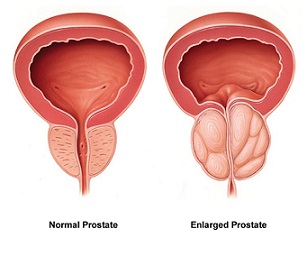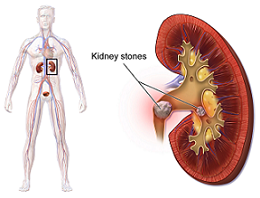Stony Brook Urology provides care for many benign (non-cancerous) conditions of the urinary tract occurring in both males and females.
For many, symptoms can be relieved with medications and lifestyle changes. Some conditions may require surgery to ease pain or improve overall quality of life.
Types of Benign Conditions
Overview
Benign Prostatic Hyperplasia (BPH) is the medical term for an enlarged prostate. In men, the prostate gland (which surrounds the urethra) tends to get bigger in men as they get older.
 Symptoms
Symptoms
- The need to urinate often, especially at night
- Trouble starting to urinate
- Having a weak urine stream
When to see a doctor
See a doctor if you are experiencing any of the above symptoms. These symptoms can be caused by other problems, so it is important for your doctor to determine if it is BPH or a different urologic condition.
Treatments we offer
- Waiting
- Waiting to see if a patient’s symptoms change / improve over time without treatment. If the condition becomes worse, the patient can chose a treatment option
- Medicine
- Option 1 - Medicine that helps to relax the muscles surrounding the urethra
- Option 2 - Medicine that keeps the prostate from growing or even shrinks the prostate
- In some cases, both types of medicine are used
- Surgical Options
- Greenlight Laser Prostatectomy
- Bipolar and Monopolar Transurethral
- Simple Prostatectomy (open and laparoscopic)
- Urolift
Our BPH Specialist: Howard L. Adler, MD, F.A.C.S.
Helpful Resources on BPH:
Kidney stones develop when a substance such as calcium, oxalate, cystine, or uric acid are at high level in the urine. The stone will move through the urinary tract and eventually be passed. If the stone gets stuck and blocks urine from passing, it may result in pain.
 Symptoms
Symptoms
- Pain - in the side, lower abdomen, or groin
- Blood in the urine
- Gravel - passing smaller stones in your urine
When to see a doctor
Visit your doctor if you are experiencing any of the symptoms above to determine a treatment method.
Treatments we offer
- Anti-inflammatory drugs (Advil, Motrin, Aleve)
- Shock wave lithotripsy (SWL) - high-energy shock waves toward the stone used to break the stone into smaller pieces. Only used for stones 1 cm or less in the kidney and upper ureter
- Percutaneous nephrolithotomy (PNL) - minimally invasive surgery to remove the stone
- Ureteroscopy - Thing scope used to view the kidney stone and remove it or break it into smaller pieces
Our stone disease specialists : David A. Schulsinger, MD, F.A.C.S. and Howard L. Adler, MD, F.A.C.S.
Helpful Resources on Stone Disease:
Overview
Urinary tract infections (UTI) occur when bacteria gets into the urethra (the tube that carries urine from the bladder to the outside). These bacteria infections can occur in either the bladder or kidney. Although UTI's are most common in women, they can still occur in men. The most common UTI cases in men can be seen in those with benign prostatic hyperplasia (BPH).
Symptoms
| Bladder Infection Symptoms | Kidney Infection Symptoms |
|---|---|
|
|
When to see a doctor
Visit your doctor if you are experiencing any of the symptoms above to determine a treatment method.
| Bladder Infection Treatments | Kidney Infection Treatments |
|---|---|
|
|
Overview
Prostatitis is when the prostate gland (only in men) becomes infected or inflamed. Prostatitis can be “acute” or “chronic,” and is usually caused by bacteria.
Symptoms
Acute Prostatitis:
- Flu-like symptoms
- Pain during urination
- Cloudy urine
Chronic Prostatitis:
- Heavy pain during urination
- Need to urinate more often
- Sudden urge to urinate in a hurry
When to see a doctor
Visit your doctor if you are:
- Having pain in your genitals or groin
- Trouble urinating
- Fever or chills
Treatments we offer
- Antibiotics
- If the case is chronic, your doctor might prescribe other medicines
Overview
A urethral stricture is the narrowing of the urethra that can happen at any point from the bladder to the tip of the penis. This condition is more common in men and rare in women and infants.
Symptoms
- Bloody Urine in Semen
- Weak urine stream
- Urine stream spraying
When to see a doctor
Visit a doctor if you are experiencing any of the above symptoms to determine the diagnosis of your condition.
Treatments we offer
- Dilation - Enlarging the stricture through gradual stretching
- Urethrotomy - Using a scope to cut through the stricture with a laser or knife
- Urethroplasty - Surgical removal of the stricture
Helpful Resources on Urethral Strictures:
Overview
Urinary incontinence is when a person leaks urine or cannot control their bladder. This is a common condition; however, it is not a normal part of aging and can be corrected.
Symptoms
Stress Incontinence :
- Leak urine when you laugh, cough, or sneeze
- Common in men after having surgery for prostate disease
Urgency Incontinence:
- Feeling a strong need to urinate suddenly
- Urge to urinate is so strong that you cannot make it to the bathroom in time
Mixed Incontinence: Having symptoms of both stress and urgency incontinence
Incontinence caused by incomplete bladder emptying: Some men cannot completely empty their bladder when urinating caused by BPH.
When to see a doctor
Visit a doctor if you are experiencing any of the above symptoms to determine that cause of the symptoms and how to treat it.
Treatments we offer
Medicines
- To relax the bladder (urgency incontinence)
- To improve urine flow (BPH)
Surgery to:
- Repair tissues supporting the bladder
- Improve flow of urine by removing part of the prostate gland
- Repair muscles that control urine flow
Electrical stimulation to nerves surrounding the bladder
Devices such as:
- Condom catheter - fits over the penis like a condom and urine drips into a bag attached to your leg
- Penis clamp - squeeze penis to keep urine from leaking
Surgical Options for Benign Conditions
What is a Cystoscopy?
A Cystoscopy is a direct visual examination of the urethra and lining of the bladder using an instrument similar to a microscope. This takes only a few minutes and can usually be performed in our offices under local anesthesia. It is commonly recommended to evaluate urinary tract problems that cannot be identified through simpler testing such as urine analysis. More than just a test, the cystoscopy can be used to treat small bladder stones, tumors, bleeding and infection, eliminating the need for more invasive surgery.
A Cystoscopy Can Rule Out the Following Conditions
|
|
Is a Cystoscopy Covered by Insurance?
Certain insurance plans may require pre-authorization before having this exam. If you are not sure, please contact your insurance company and/or primary physician beforehand.
Getting a Cystoscopy
Prior to a Cystoscopy please review the list below:
- If you are allergic to any medications, have a history of frequent urine infections, or need to take antibiotics before having dental work, please notify your doctor or nurse. In some cases, additional antibiotics may be required before cystoscopy.
- This procedure cannot be performed safely if you have a urinary tract infection. The urologist may order a urinalysis and urine culture if they have not been performed recently. These tests must be done before your appointment. PLEASE NOTE: If your urologist has ordered urine tests before cystoscopy, we must have the complete results before performing the cystoscopy. If the tests indicate that you have an infection, your urologist will notify you and prescribe antibiotics. The appointment for cystoscopy may also need to be changed if this is the case.
- If you take aspirin, anti-inflammatory drugs (such as Motrin, Alleve, Vioxx, Celebrex etc.), or any blood thinners (such as Coumadin or Plavix). You may need to temporarily stop these medications prior to cystoscopy. If you are not sure, review your medications with your doctor or nurse. If another doctor prescribed these medications, you must contact them before you stop taking them. If they cannot be safely interrupted, please contact our office before coming in.
What does the procedure involve?
The cystoscope is a very narrow instrument with lenses, much like a telescope or microscope. The procedure is usually performed while the patient is under local or general anesthesia. Once the patient is placed in the stirrup position, a cystoscope is lubricated and inserted through the urethra, and sterile liquid (water or saline) is used to fill the bladder for optimal examination. It is not usually painful, but there is often some mild discomfort during the procedure. Once the cystoscope is inserted into the bladder, an extension can be used to visualize the ureters (the tubes that carry urine from the kidneys to the bladder). Depending on what needs to be accomplished, the entire procedure may last a few minutes to possibly 20 minutes.
Are there any possible complications?
The patient may experience mild burning during urination and/or small amounts of blood in their urine. This is considered normal within the first 24 hours. Patients are encouraged to drink extra fluids to relieve those symptoms and help prevent urinary tract infections. However, if symptoms persist or if there is severe bleeding and/or pain, the physician should be contacted. Antibiotics may be prescribed for one or two days prophylactically, immediately following a cystoscopy. If other signs of infection, such as pain, chills, or fever develop, the physician should be contacted immediately.
Additional Information
What is a Ureteroscopy?
A ureteroscopy is a procedure that uses a small flexible scope that is inserted into the bladder and ureter. This allows a urologist to look into the ureter to find a kidney stone. The urologist can then proceed to remove the kidney stone. This procedure may be done when kidney stones are lodged in the ureter and are too large to be passed, or if a stone causes bleeding.
What to Expect Prior to the Procedure
The patient will receive a local anesthetic to numb the area of the body. Next, the urologist will insert the ureteroscope into the urethra. The scope will fill the bladder with a sterile liquid that will stretch the bladder, allowing for a better view. When the urologist finds the stone, they will use a tiny wire basket to grab and remove it from the ureter. The procedure usually lasts 15-30 minutes.
Be sure not to eat or drink anything after midnight on the day of the procedure.
After the Procedure
Depending on the procedure, you may need a catheter to drain urine. You may also be prescribed pain medication or antibiotics. Urination may be painful or contain blood at first. If the blood is excessive, please notify medical personnel.
Be sure to:
- Drink plenty of water
- Eat foods that are high in fiber
- Avoid heavy lifting for 6 weeks

